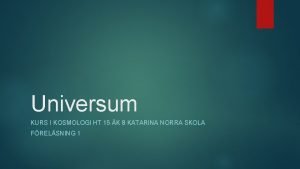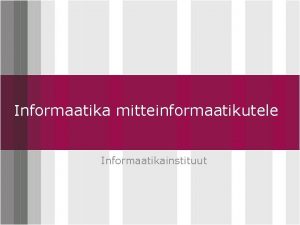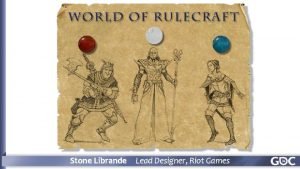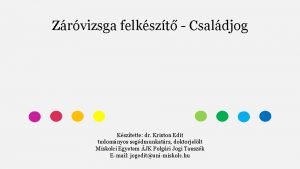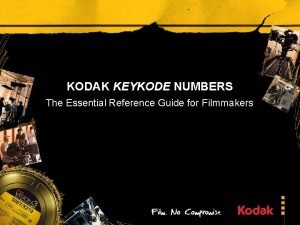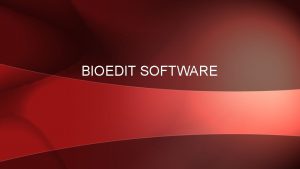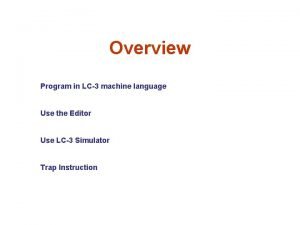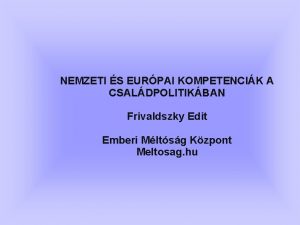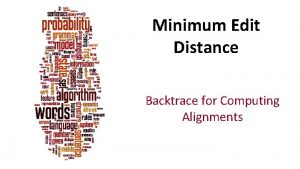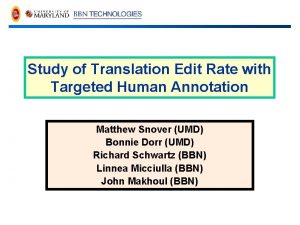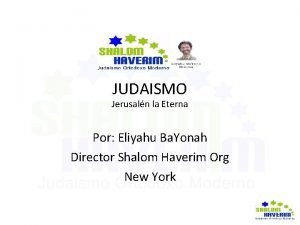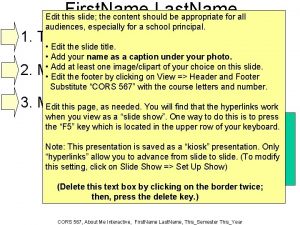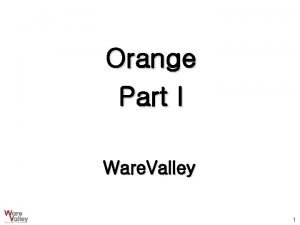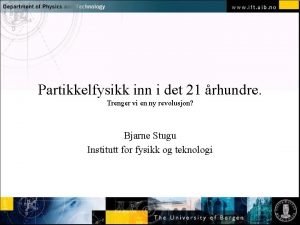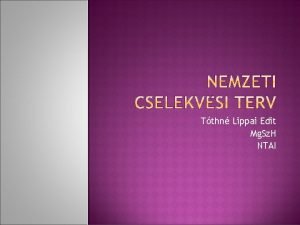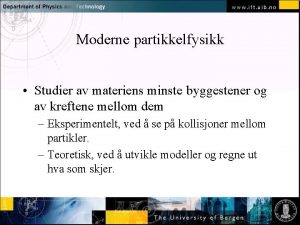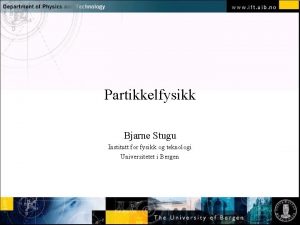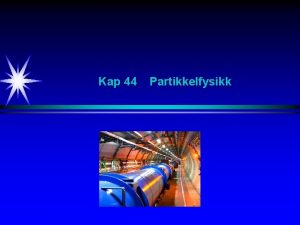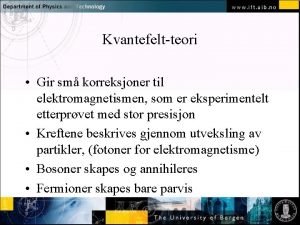Normal text click to edit Partikkelfysikk og kosmologi










































- Slides: 42

Normal text - click to edit Partikkelfysikk og kosmologi Bjarne Stugu Institutt for fysikk og teknologi Universitetet i Bergen

Disposisjon Normal text - click to edit 1) Hva vi vet i partikkelfysikk (historisk oversikt). 2) Large. Hadron. Collider sin rolle 3) Link til astrofysikk/kosmologi

Kilder Normal text - click to edit • Eget materiale, som bl. a. bygger på – Wikipedia – Andre presentasjoner • Presentasjoner av Rolf Landua/Cern til lignende grupper

Normal text - click to edit Del 1, En historisk oversikt

Men hvordan Det må finnes noen skapes dyr og minste udelelige planter av det ATOMERNormal som er textsmuldrende - click to støvet? ? materiens byggestener! Smuldrer alt opp til mindre og mindre edit støvkorn?

Hva er materie? Normal text - click to edit • Atomer postulert allerede av Demokrit – Hvis det ikke fantes noen minste byggestener, så ville alt smuldre opp (jeg har lest argumentet i ’Sofies verden’) – Stemmer dette for kollisjoner ved høye energier?

Energiskalaer på mikronivå (1 e. V = 1, 6 x 10 -19 J) Normal text - click to edit • Gassmolekyl ved romtemperatur: – E = k. T = 0, 025 e. V (k er Boltzmanns konstant) • Molekylær og intermolykelær bindingsenergi – Van der Waals bindinger: ~0, 01 -0, 1 e. V – Kovalent og ionebinding: 1 -10 e. V > k. T • Atomær ionisasjonsenergi: 1 -20 e. V >>k. T • Radioaktiv stråling: 0, 5 – 10 Me. V >>> k. T

Demokrit hadde rett, atomene er udelelige i naturlige jordiske fenomener Normal text - click to edit • Atomene er små, og andre teorier var plausible, så rundt ca år 1890 var atomteorien fortsatt ikke bekreftet.

Discovery of the electron e- 1897 Electrodes D+E : electric field External coils: magnetic field e- J. J. Thomson Cathode ray experiments (~ TV) 'Rays' are charged corpuscles* with unique charge/mass ratio e- *later called 'electrons' Electrons are sub-atomic particles! His 'plumpudding' model of the atom (1904)

Atom Botanikeren Brown så på pollen i vann, og trodde først at dette var tegn til liv, men fant senere at inorganisk støv oppførte seg på samme måte Robert Brown (1827) observes random walk of small particles suspended in a fluid Albert Einstein (1905) explains by kinetic theory that the motion is due to the bombardment by molecules Francois Perrin (1907) uses Einstein's formula to confirm theory and measure Avogadro's number The existence of atoms was proven 1905

Rutherfords eksperiment: alfapartikler på gullfolie Normal texter som - click Dette skjer hvis materie en grøt med rosiner to edit Dette observerte Rutherford, noe som passer med tunge kjerner Fra “Wikimedia Commons”

Bohrs atommodell Normal text - click to edit • Atomer som mini solsystem, men tunge positive kjerner og kretsende elektroner • Bare visse baner var tillatte • Uakseptabel teori i lys av elektromagnetisme.

Den kvantemekaniske revolusjon Normal text - click to edit • Schrödinger energiligning. – • • (Etot = Ekin+ Epot etter visse regler) Finner bestemte energinivåer, men postulerer at partikkelbaner ikke kan bestemmes eksakt. Faststoff-fysikk, kjerne+partikkelfysikk og kjemi er basert på kvantemekanikk. • Har bestått alle tester

Illustrasjon av bølgefunksjon (under). Elektron-og kjerneskyer for helium (til venstre) Normal (figurer fra Wikipedia) text - click to edit

I 1932 er atommodellen godt etablert Normal text - click to edit • Tunge kjerner med nøytroner og protoner • Elektroner i ”skyer” omkring, beskrevet etter kvantemekaniske prinsipper

Hvor lenge var Adam i paradis? Normal text - click to edit • Til 1933, da ble positronet funnet. – Forutsagt av Dirac noen år tidligere gjennom sin relativistiske kvantemekanikk. – Alle partikler har sine antipartikler med motsatt ladning , mens alle andre egenskaper er beholdt. (noen nøytrale partikler er sine egne antipartikler)

e+ Fields ‘Electromagnetic’ interaction Discovery of the positron Dirac was right! Anderson (1932)

β-stråling dn/d. E Normal text - click to edit Emax 0, 5 -1 Me. V E Kontinuerlig energispektrum, midlere E = 1/3 Emax Er energien bevart? Bare hvis en postulerer en ny partikkel, nøytrinoet.

Er protonet en elementæpartikkel? Normal text - click to edit • Rutherfords eksperiment på nytt, men med høyere energi. Hva skjer? – Mange nye partikler, bl. a særpartikler. – Protonet har utstrekning – Protonet har struktur – Kvarkmodell (1964)

Discovery of quarks Electron-Proton scattering Normal text - click to edit 1956 Hofstadter: measured finite proton radius Stanford Linear Accelerator Centre 1967 Friedmann, Kendall, Taylor (SLAC): ‘hard scattering’ of electron on three ‘point-like particles’ Measured cross-sections perfectly compatible with presence of 2 up- and 1 down-quark in proton

CERNs ISR (R. I. P. ) Intersecting Storage Rings Normal text - click to edit p-p kollisjoner i 8 punkter

Normal text - click to edit Kjell Johnsen 1921 -2007

. 1. Progress report on the development of a method to detect fractional charges in water and its application to a search for quarks at the ISR Von Dardel, G; Henning, S; Malmenryd, G CERN-ISRC-70 -33 -Add-1. - Geneva : CERN, 1 Oct 1971. - 4 p Fulltext Detailed record - Similar records 2. Search at the ISR for quarks produced at small angles - Rome-CERN Collaboration. CERN-ISRC-70 -30. - Geneva : CERN, 7 Dec 1970. - 2 p Fulltext Detailed record - Similar records 3. Search for quarks at the ISR Albrow, M G; Clegg, A B; Sens, J C- CERN-Holland-Lancaster-Manchester Collaboration. CERN-ISRC-70 -16. - Geneva : CERN, 15 Sep 1970. - 4 p Fulltext Detailed record - Similar records 4. The use of a special gate to search for quarks at the ISR in events of favourable topology - Pisa. Stony Brook Collaboration. CERN-ISRC-69 -12 -Add-1. - Geneva : CERN, 8 Dec 1970. - 14 p Fulltext Detailed record - Similar records 5. Search for quarks at the ISR - Saclay-Strasbourg Collaboration. CERN-ISRC-69 -11 -Add-5. - Geneva : CERN, 7 Jan 1971. - 3 p Fulltext Detailed record - Similar records 6. Search for quarks in the British-Scandinavian large angle spectrometer - British-Scandinavian Collaboration. CERN-ISRC-71 -9. - Geneva : CERN, 1971. - 15 p Ful

Normal text - Man søkte videre etter kvarker: f. eks ved å skyte dem ut av protonet med click tonøytrinoer edit Kvarker er aldri frie partikler

Ikke frie kvarker, men Normal text - click to edit • Baryoner, som består av tre kvarker • Mesoner, som består av en kvark og en antikvark. • Leptoner, som elektronet, som er en ”punktpartikkel”

En kollisjon mellom kvarker: Normal text - click to edit

Vekselvirkninger (krefter, felter, potensialer) • Normal text click to edit Coulomb kraft: • Gravitasjonskraft • 1/r 2 Vi kan tegne feltlinjer

Potensialene Normal text - click to edit • Enklere å uttrykke seg v. h. a. energibevaring, enn å bruke kompliserte kraftvektorer • Potensial: virkningen av en kraftkilde på en standardisert probe (enhetsladning) • QM: sier potensial, mener gjerne potensiell energi

Kvantefelt-teori Normal text - click to edit • Gir små korreksjoner til elektromagnetismen, som er eksperimentelt etterprøvet med stor presisjon • Kreftene beskrives gjennom utveksling av partikler, (fotoner for elektromagnetisme)

Fields 1934 - 1948 Quantum Electrodynamics Feynman, Tomonaga, Schwinger “Renormalization” The ‘naked’ electron + vacuum fluctuations = measured electron (“infinite” - “infinite” = “finite”) R. P. Feynman All paths are possible (‘multiple slit experiment’) Feynman diagrams Precise computation rules - in graphical form Feynman diagrams later became a graphical way to represent all kinds of particle interactions

Feynman diagrammer for å beskrive prosessene med vekselvirkningspartikler d g Normal text click to edit + e u W g e+ νe u d+ e+ + νe d u + e- + νe Z 0

Fields ‘Strong’ interaction Back to the strong force: keeping protons and neutrons together Exchange of massive particle Pion Modified Coulomb law Yukawa (1934) Allowed by uncertainty relation: 1. 4 fm ~ 140 Me. V

Elektrosvak Kraft Normal text - click to edit

De fire kraftpotensialene Newtons gravitasjon Normal text - click to edit (+korreksjoner p. g. a. Einstein) Coulombkraften Svak kjernekraft Sterk kraft (mellom kvarker). Nb: øker med avstand. Ikke mulig med enkle diagrammer Hvilke sammenhenger finnes?

Yukawa og Coulomb potensialer Normal text - click to edit Hvis kurven har helning så vil legemer trekkes mot sentrum

Mot Standardmodellen Normal text - click to edit At the end of the 1950 s V-A theory was the "standard model" of weak interactions. Its major drawback was its bad high-energy behaviour, which prompted various ideas to cure the problem of infinities. Guided by quantum electrodynamics, a gauge theory, attempts were made to construct a gauge theory of weak interactions, and in the mid-1960 s the hypothesized charged intermediate vector boson (W±) was complemented with a neutral partner to achieve the required cancellations. The invention of the Higgs mechanism solved the problem of having both a gauge theory and massive mediators of weak interactions. The progress made by Sheldon Glashow, Abdus Salam and Steven Weinberg was completed by the work of Martinus Veltman and Gerard 't Hooft, which proved the renormalizability of theory. So, as 1971 turned to 1972, a viable theory of weak interactions that claimed weak neutral currents as a crucial ingredient was proposed, challenging the experimental groups to provide "yes" or "no" as an answer to the question "do neutral currents exist? ". Sitat: CERN Courier 4 oktober 2004 = eksistens av Z-bosonet

Svak nøytral strøm funnet i boblekammeret ”Gargamelle” Normal text - click to edit tre hadroner, ingen leptoner Cerns største triumf på 1970 tallet

Kan alt beskrives med samme teori? Hva betyr ”samme teori”? Normal text - click to edit • Må ha en relasjon mellom ladningene i de forskjellige kreftene. • Elektrosvak teori g er svak ladning e er elektrisk ladning ofte brukes α=e 2/(2ε 0 hc) istedenfor ladning

1973 Colour charge Δ++ three up-quarks with parallel spin, in a symmetric state (u, u, u) But: three fermions not allowed to be in identical states (Pauli exclusion principle) The three quarks must be different in one quantum number: “colour” (Bardeen, Fritzsch, Gell-Mann) Only colour-neutral bound states are allowed MESONS = Quark-Antiquark BARYONS = 3 -Quark states Colour-force transmitted by (eight) gluons GLUONS CARRY COLOUR CHARGE - SELF-INTERACTION ! Positive pion

1973 Gluons are massless carriers of the strong force There are 3 x 3 - 1 = 8 different gluons Gluons carry colour charge -> self-interaction Self-interaction of gluons Potential rises linearly with distance (for large r) Small distances: asymptotic freedom

1973 Discovery of Gluons Normal text - click to edit Bjørn Wiik (1937 -1999) PETRA Storage Ring, 1979, DESY (Hamburg)

Tre av kreftene beskrives godt som kvantefeltteorier. Dette kalles ‘Standardmodellen’. Normal text - click to edit • Forening av svake og elektromagnetiske vekselvirkninger • Ingen relasjon mellom sterk og elektrosvak ladning. • Hva med gravitasjon? • Kvarker, leptoner, fotoner, gluoner…. • Mer om dette i morgen.
 Triangelmetoden
Triangelmetoden Hard edit vs soft edit
Hard edit vs soft edit Click to edit master title style
Click to edit master title style Informaatika mitteinformaatikutele
Informaatika mitteinformaatikutele Title style
Title style Click to edit master title style
Click to edit master title style Click clever click safe
Click clever click safe Cyber safety
Cyber safety Clever click
Clever click Click clever click safe
Click clever click safe Text to text text to self text to world
Text to text text to self text to world Click here to add text
Click here to add text Click to add text
Click to add text It's normal to be normal
It's normal to be normal Kriston edit
Kriston edit Kronos workforce central 8
Kronos workforce central 8 Quick edit+
Quick edit+ How should you always start your peer edit
How should you always start your peer edit Minimum edit distance nlp
Minimum edit distance nlp Edit decision list
Edit decision list Please feel free to edit
Please feel free to edit Every day edit
Every day edit Bioedit
Bioedit Lc3 multiply
Lc3 multiply Frivaldszky edit
Frivaldszky edit Minimum edit distance backtrace
Minimum edit distance backtrace Forms.gle down
Forms.gle down Yang merupakan modus edit, kecuali
Yang merupakan modus edit, kecuali Daily oral language sentences
Daily oral language sentences Attatc
Attatc Gene edit
Gene edit How to edit and publish a video with maker
How to edit and publish a video with maker Writing broadcast news
Writing broadcast news Translation edit rate
Translation edit rate Cimco edit cena
Cimco edit cena Edit
Edit Name edit
Name edit Edit
Edit 오렌지 edit mode
오렌지 edit mode Hva betyr edit
Hva betyr edit Cégértékelés
Cégértékelés H ntai
H ntai Menu edit
Menu edit
